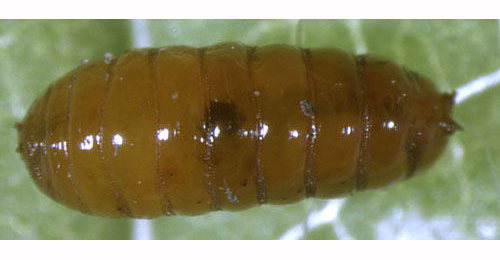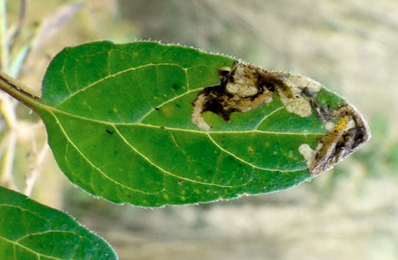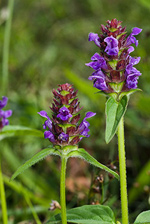|
||||||
|
PRUNELLA. Selfheal. [Lamiaceae] |
|
|
Three species of Prunella are recorded in Britain. These include the native Selfheal (P. vulgaris). Eight British miners are recorded on Prunella. A key to the European miners recorded on Prunella is provided in Bladmineerders van Europa. |
|
Key for the identification of the known mines of British |
1a >Stem mine. A shallow, inconspicuous external stem mine. Pupation in stem near a node (Spencer, 1972b: 29). |
|
Ophiomyia labiatarum Hering, 1937 [Diptera: Agromyzidae]. |
1b > Leaf-miner and case-bearer: The larva lives outside the mine, protected by a case, and feeds on the underlying plant tissues via a hole cut in the epidermis. From that point it eats away as much leaf tissue as it can reach without fully entering the mine. Mine does not contain frass (Coleophora species) |
1c > Leaf-miner, but not a case-bearer: The larva lives mainly inside the mine. Mine usually contains frass. In later instars the larva may live sandwiched between two more or less circular sections cut from the leaf. |
2 > Leaf-miner and case-bearer: Blotch mines reaching the edge of the leaf, initially pale green turning brownish white, are caused by the larva feeding on the underside of a leaf. The fully developed case is slender, shining black brown, about 9 mm long. Towards the end a narrow, transparent yellowish ventral keel. Mouth angle 50-60°. Cases on the leaf underside. |
|
Coleophora albitarsella Zeller, 1849 [Lepidoptera: Coleophoridae]. |
3a > Leaf-miner: Rather long corridor winding through the leaf, regularly crossing itself. The corridor later widens considerably. Frass normally in a narrow central line, but may also lie along the side, or be absent. The larva regularly leaves a mine and restarts elsewhere. |
|
Apteropeda globosa (Illiger, 1794) [Coleoptera: Chrysomelidae]. |
| 3b > Leaf-miner: Rather long full depth corridor that winds freely through the leaf and may cross itself. In the end the corridor widens considerably. Frass mostly in a narrow central line, but may also be deposited along the sides or be missing. The larvae regular leave a mine to restart elsewhere. Pupation outside the mine. Neither larva or mine can be distinguished from that of related species. |
|
Apteropeda orbiculata (Marsham, 1802) [Coleoptera: Chrysomelidae]. |
3c > Leaf-miner: A linear-blotch mine, first instar mine is linear, later developing into a conspicuous white blotch. Frass greenish diffused (Spencer, 1972b: 46, 47 (fig. 138); Spencer, 1976: 166). The mine begins with a long, upper-surface, slender corridor. After a moult the larva changes its behaviour, and makes a large, upper-surface primary blotch without apparent feeding lines. Often the blotch overruns more or less the initial corridor. Frass in the corridor liquified to form a wide green band, with a few tiny black granules along the sides. Pupation outside the mine. A narrow gallery leading to a largish blotch on the upper surface. Frass is green and indistinct in the gallery - small grains may be seen at the gallery edge. |
 Amauromyza labiatarum puparium Image: © Willem Ellis (Bladmineerders van Europa) |
|
Amauromyza labiatarum (Hendel, 1920) [Diptera: Agromyzidae]. |
3d > Leaf-miner: Rather narrow corridor, untidy and sometimes branched, starting from the base of the leaf, in particular the midrib. Sides of the corridor irregularly eaten out, not really parallel. Frass mostly present, and then in a central line. The larva is capable of leaving the mine and start a new one elsewhere. These later mines are much broader, and the frass is scattered irregularly.. |
 Mine of Orthochaetes insignis on Prunella vulgaris Image: © Jean-Yves Baugnée (Bladmineerders van Europa) |
|
Orthochaetes insignis (Aube, 1863) [Coleoptera: Curculionidae]. |
3e > Leaf-miner: Egg at the upperside of the leaf. The mine is an extremely long corridor, often following the midrib or the leaf margin, with frass in a narrow central line, widening in te end into an irregular elongate blotch. Corridor sides somehwat irregularly scalloped out, especially towards the end. The larva may move, all the while mining, to another, even a third, leaf by way of the petioles and stem. Therefore one leaf may have only a narrow corridor, another a blotch. Pupation external. Mines mainly in the lowest leaves, difficult to find. |
 Mine of Trifurcula headleyella on Prunella vulgaris Image: © Willem Ellis (Bladmineerders van Europa) |
|
Trifurcula headleyella (Stainton, 1854) [Lepidoptera: Nepticulidae]. |
3f > Leaf-miner: Full depth, initially a much branched corridor, irregular in width, in the end almost a blotch. The mine has openings by which part of the frass is ejected. The larvae frequently leave the mine to restart elsewhere. Older larva live free and cause window feeding, often erasing their old mines. In Coltsfoot also pseudo-mines are made, when the larva eats away the lower epidermis with the leaf tissue, but spares the dense hair cover. |
|
Phytosciara halterata Lengersdorf, 1926 [Diptera: Sciaridae]. |
| Last updated 06-Jul-2019 Brian Pitkin | ||

